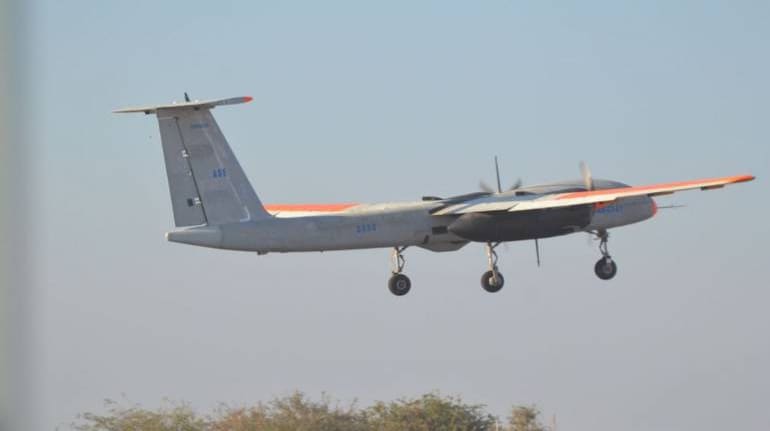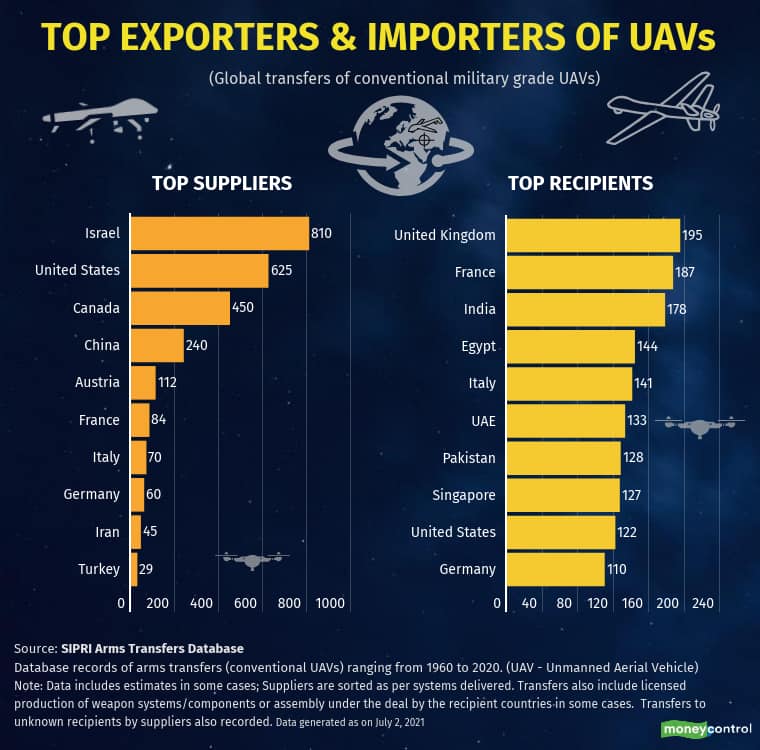CHAITANYA MALLAPUR

On June 27 last month, India unexpectedly woke up to a technological and cultural phenomenon, which has existed in the country for more than two decades - drones or unmanned aerial vehicles (UAVs). Security agencies reported the first ever drone attack, carrying out two low intensity explosions in the technical area of the Jammu Air Force station.
The drones used in the Jammu attack are expected to be low cost, modified commercial drones, experts suggest. The attack has raised concerns over the advanced warfare means used by terror outfits and their operators across the border.
With investigation still underway, the role and involvement of the drone operators involved in the attack are yet to be established. However, preliminary findings reveal that the use of explosives in the attack are likely to have had their origins in Pakistan, as per media reports.
“Even though there is no evidence so far on where the drones took off from or returned to, a Jammu Kashmir Police officer said multiple past investigations have suggested that similar drones used to drop weapons in earlier cases, were flown from locations across the border,” Moneycontrol reported on July 4. The report also suggests several instances of drone sightings in the last one month along the border region in Jammu.
Regulation and control over domestic use of UAVs
Unmanned aerial vehicles or drones come in various sizes with different functionalities like video/photography, mapping, surveillance, deliveries, making announcements and spraying insecticides on farms, among other activities. Why, drones are being used in places as diverse as weddings and public events!
With such large-scale – nay abundant - use, drones are perfectly handy in the possession of rogue elements.
To regulate the use of drones, the government has issued guidelines under the Unmanned Aircraft System Rules, 2021. Under this, those who intend to operate drones will need to seek a permit and a license for using it, based on the categorisation of UAVs.
Likewise, those who intend to import such systems in India must obtain approval and permits from the government.
Says Ankit Mehta, Co-Founder & CEO of ideaForge, one of the largest private manufacturers of drones for defence, homeland security and industrial applications: “Drones used in public events need to have a UIN (Unique Identification Number) or permit from the government and should only take off when given permission from the Digital Sky Platform.”
About 42 drones have been issued a UIN on the Digital Sky Platform, as of July 12.
“More people need to be brought under the fold of regulation so that very few are left out and can be traced through their license (number) in case of an untoward incident. Similarly, it is important to deploy counter drone solutions to detect the threat and ensure safety of our own systems used for ISR (intelligence, surveillance, and reconnaissance) purposes at the same time,” he adds.
India's drone market on the rise
India is said to be the fastest growing drone market in the world. It is predicted to mushroom to $885 million by 2021, according to a January 2020 PwC report, and is expected to reach $1,810 million by FY 2026, growing at a CAGR (compound annual growth rate) of 14.61 percent.
The global drone market is to scale over $43 billion in 2024 from $14 billion in 2018 at a CAGR of 20.5 percent.
Adds Mehta: “The drone market in India and worldwide is evolving and exploding, and we should let it happen in terms of technological and economic advancements for the right purposes. At the same time, it should be ensured that these advancements take place in a controlled manner.”
To be sure, there are benefits galore. Last month it was reported that ANRA Technologies, a global drone services provider, will hold experimental deliveries of medicines in collaboration with the Indian Institute of Technology (IIT) Ropar and with Swiggy for food deliveries.
Likewise, Throttle Aerospace and Daksha Unmanned Systems in collaboration with Narayana Healthcare will conduct deliveries of medicines in Gauribidanur in Karnataka and Thiruvalluvar outside Chennai.
In addition to commercial utilisation, UAVs have been increasingly used for defence and military purposes globally for surveillance, reconnaissance, and warfare.
Third largest importer
India is the third largest importer of (military grade) UAVs, with 6.8 percent share of the total UAV transfers or deliveries reported across the globe ending 2020, according to Stockholm International Peace Research Institute’s (SIPRIs) Arms Transfers database, analysed by Moneycontrol.
Since the 1960’s, an estimated 2,892 orders for UAVs have been recorded with the supplier countries, of which over 2,600 transfers or deliveries have taken place, SIPRI data show.
Of the estimated 2,612 UAVs delivered to countries, 11 percent are armed UAVs while others are mostly surveillance and reconnaissance drones.
Experts point out that the drones that India imports are mostly for military or defence purposes and larger in size, not the ones visible at public events.
Among the types of weapons covered under SIPRI’s database, UAVs fall under the aircraft systems category. The aircraft segment covers all fixed-wing aircraft and helicopters, including unmanned reconnaissance/surveillance aircraft with a minimum loaded weight of 20 kg, except microlight aircraft, powered and unpowered gliders and target drones.
SIPRI maintains data of deals between arms suppliers and recipients over a specific time. Transfers also include licensed production of weapon systems, components, or assembly under the deal by the recipient countries, in some cases.
The trade registry records orders placed to the supplier nations and deliveries are received by the recipients. In cases where a delivery has been identified but either the supplier or the recipient is not recognized with certainty, the transfers are registered as ‘unknown’ suppliers or recipients.

The United Kingdom is the largest recipient or importer of UAVs (195) ending 2020, followed by France (187), India (178), Egypt (144) and Italy (141). These countries account for 32 percent share of total UAVs delivered or received worldwide.India’s western neighbour, Pakistan is the seventh largest importer with 128 UAVs, according to SIPRI. Pakistan’s official UAV imports come majorly from Italy, Germany, China, and the United States.
On the other hand, Israel is the largest supplier of UAVs in the world, having transferred 810 UAVs ending 2020, followed by the United States (625), Canada (450), China (240) and Austria (112).
Japan was the first country to import or receive (armed) UAVs in 1968-69 from the USA, as per records maintained by the Swedish think tank.
India’s Israel imports
India’s first UAV import was reported in 1998 from Israel, as per SIPRI’s records. Most of the country’s imported drones are surveillance and reconnaissance types.
The drones or UAVs that India imports can be largely categorised under MALE (medium-altitude, long endurance), HALE (high-altitude, long endurance) and Tactical (having a fairly long flight time and range) systems, largely used for defence purposes, says Mehta. “We are now also importing some of the smaller systems from Israel,” he adds.
Say Sameer Patil, Fellow, International Security Studies Programme, Gateway House and former Assistant Director at the National Security Council Secretariat in Prime Minister’s Office, New Delhi: "Surveillance drones imported from Israel have proved to be of great help to the Indian security forces, as they are capable of flying higher with longer endurance, which has helped reduce the burden on the security forces in manning the borders to some extent."
For a long time, we have been using these systems for surveillance and reconnaissance purposes along both our borders with China and Pakistan, he points out.
“India is now planning to get drones from the USA, which are capable of carrying weapons, based on their performance in the Khyber Pakhtunkhwa region and in Syria. However, funding has been an issue in procuring these drones as they are expensive,” Patil notes.
India is in the process of acquiring 30 armed MQ-9 Reaper drones from the US at an estimated $3 billion deal. However, there is some delay due to high costs, reports suggest.
The Indian Navy is using two MQ-9B Sea Guardian drones for surveillance over the Indian Ocean, taken on lease from a US firm since November last year.
Currently, all the unmanned vehicles deployed by the Indian armed forces are ISR drones. India also does have some loitering munitions (also known as a suicide drones) imported from Israel, Mehta points out.
UAVs are also used in keeping watch on mass gatherings/protestors, counter insurgency operations as well as in maritime security, adds Patil.
Made in India
In addition to imports, India has also developed its own UAVs through public sector units and private companies. Some of these listed include Rustom, Nishant, Panchi and Netra, while micro and mini UAVs are registered as Black Kite, Golden Hawk, Pushpak, Imperial Eagle and Sly Bird.There are more than 150 drone start-ups mushrooming in India, indicating the wide scope of evolution of the drone and UAV ecosystem, going forward.
In January, ideaForge received one of the largest small drone contracts worth $20 million for SWITCH 1.0 UAVs, which will be inducted in the Indian armed forces. These UAVs are capable of long duration operations, long endurance surveillance and security inspection.With domestically manufactured drones getting inducted in defence and other public services, India’s UAV industry is looking ahead. Given the security perception and their multifarious commercial and social uses, that appears to be the way ahead.
No comments:
Post a Comment